Intermittent Fasting: A Beginner’s Guide to the Fasting Diet
Fasting is something that’s played a key role in virtually all of the world’s major religions and dates back millions of years. Today, though, while fasting is still observed for many religious purposes, it’s become a new lifestyle that helps individuals lose weight, have more energy, and fight disease.
While fasting isn’t a new concept, intermittent fasting is something that has emerged in the past few years. It has gained popularity due to the incredible benefits it offers against signs of aging and disease.
Keep reading to learn about intermittent fasting and why this may want to be a lifestyle change you make.
Understanding Intermittent Fasting
Intermittent fasting is a process that involves cycling in and out of periods where you eat and don’t eat. While people do experience (often significant) weight loss with this eating schedule, it’s not as much of a diet plan as it is a lifestyle choice that provides a wide array of health benefits.
There are several methods used with intermittent fasting. These include:
The 5:2 Method
This is the method that allows you to eat normally for five days a week. The two days after are for fasting, but you still eat. The goal is to keep calorie intake on this day between 500 and 600.
The Eat-Stop-Eat Method
This method is a bit different. With this, you restrict all food for a period of 24 hours. This is repeated two to three times per week.
The 16/8 Method
Here, you consume all your daily calories within a shortened period of time. In most cases, you eat in a period of six to eight hours.
The remaining 14 to 16 hours during the day, you fast. This is the method that can be done daily, or several times a week.
Benefits of Intermittent Fasting
When you switch to intermittent fasting, it will expand your limits while boosting your performance in several ways. Some of the specific benefits offered by this way of eating include:
- Increase energy
- Reduce bad cholesterol
- Protect against various neurodegenerative diseases
- Boost weight loss
- Promote longevity
- Reduce insulin resistance
- Promote cellular repair
As you can see, the benefits are vast. As a result, this may be something you should consider trying.
Tips to Make the Most of Intermittent Fasting
While not eating for specific amounts of time alone offers health benefits, if you want to make the most of this lifestyle choice, there are a few other tips you need to use.
It can’t be a free-for-all when you do eat, as this is going to negate many of the benefits this way of eating offers. Some additional tips include:
- Avoid refined grains and sugars (choose low-carb snacks when possible)
- Don’t snack between meals
- Remain active
- Avoid snacking or eating in the evening and at night
By using these tips, the results of your intermittent fasting will be much more evident.
Be Healthier and Happier with Intermittent Fasting
As you can see, there are several options to consider if you are interested in intermittent fasting. As a result, you aren’t going to feel as deprived or hungry while following this way of eating.
Do you want to make a change to be healthier and happier? If so, let us help! Visit the 21 Day Transformation Challenge to learn more.

You Might also like
-
No More Fitness Chores: How To Enjoy Working Out For Lasting Health
No More Fitness Chores: How To Enjoy Working Out For Lasting Health
Do you actually love exercise? Probably not, and you’re not alone. Most don’t know how to enjoy working out. Here’s the secret to loving workouts for life.
Do you hate working out?
Your genes might be to blame! Studies have shown that there are some people who are genetically predisposed to hating exercise. That might help to explain why only about 20 percent of Americans meet the federal government’s recommendations for physical activity.
But you can’t put all the blame on genetics when it comes to America’s exercise problem. There are also lots of people out there who don’t have fun while exercising simply because they haven’t taken the time to learn how to enjoy working out.
If you’re one of these people, you could be missing out on all the potential benefits of establishing a regular exercise routine. You could also be cutting years off your life and skipping the chance to make yourself a more physically fit person over time.
Here are 11 tips that’ll help you snap out of it and embrace working out.
Set Fitness Goals for Yourself From the Beginning
Most people know they should get more exercise than they do. So every now and then, they’ll sign up for a gym membership and start going to the gym every day after work. Or they’ll get into the habit of going for a walk or a run at the park.
There is (obviously!) nothing wrong with trying to make a commitment to working out. But you’re going to have a heck of a time keeping up with the commitment if you don’t have any goals in mind before you begin.
Is your goal to:
- Lose the extra 20 pounds you’ve been carrying around for a few years now?
- Build up your upper body strength and core so that you don’t have back problems anymore?
- Run five miles every few days to break a sweat and break out of the monotony of spending all day in an office?
Setting goals is arguably the most important part of starting a successful workout routine. Goals will keep you on track and help you avoid running into a wall at some point when your initial motivation runs out.
It’s also important to set new goals for yourself along the way. Once you’ve lost weight, gotten stronger, and run five miles, you should push yourself to set and meet other goals. You’ll find out how to enjoy working out by taking this approach to exercise.
Start Slow and Avoid Trying to Hit All Your Goals at Once
The biggest mistake people make when they first start working out is that they often try to accomplish all the goals they set for themselves at once.
They want to lose 20 pounds in a week so they spend three hours in the gym every day. They want to be able to improve their bench press by 50 pounds after just a few workouts so they work their muscles to the point of sheer exhaustion every time they’re lifting. They want to run five miles so they run each and every day for a few weeks.
If you haven’t worked out regularly in a long time, you could put your body at real risk by overdoing it at the beginning. Your muscles and the other parts of your body aren’t ready for workouts this intense.
You’re also going to expend all your mental energy if you aren’t careful. You might reach your goals, but you could also burn out in the process and stop working out once you do. That’ll be counterproductive and won’t allow you to develop lifelong workout habits.
Start off slow instead and ease your way into working out. It’ll be better for your mind and body and motivate you to continue coming back for more.
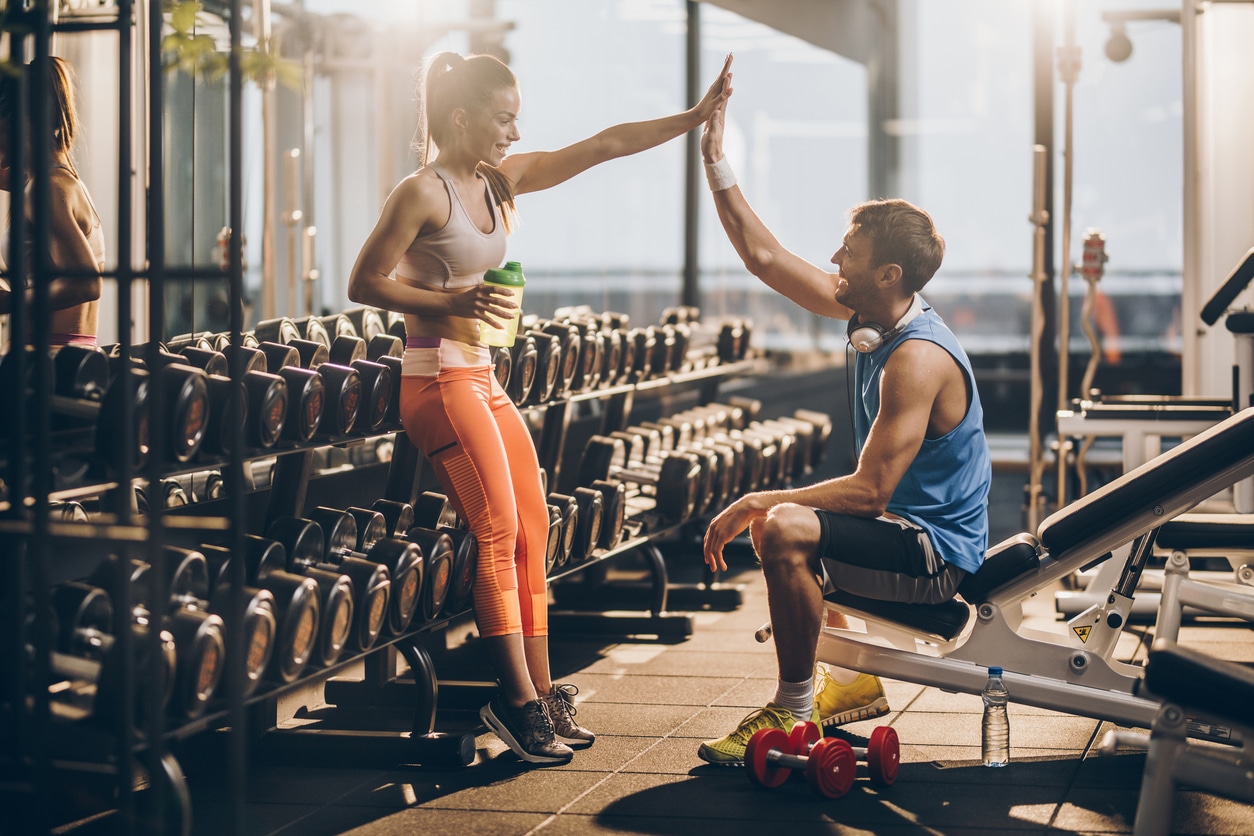
Find Someone Who Wants to Work Out With You on a Regular Basis
If you know that you struggle to motivate yourself to go to the gym or the park to work out, it might be a good idea for you to put out feelers and find a workout buddy.
Studies have suggested that those who work out with someone else tend to work out more often and have better workouts. This is especially true when people find workout buddies who are capable of providing them with emotional support.
This doesn’t necessarily mean you just want to choose anyone to be your workout buddy. In some cases, your workout buddy might actually end up dragging you down if you have to do all the heavy lifting as far as emotional support is concerned.
Before you agree to work out regularly with a person, make sure they’re as committed to exercising as you are. Make sure they want to do similar workouts to you as well.
By teaming up with someone else, you can make it easier to get motivated to go to the gym and swap workout stories with someone who can relate to you. It’ll make working out more enjoyable for both of you and make it feel more fun.
Experiment With Different Workout Routines (and Switch Up Your Routine Regularly!)
When you first start working out on a regular basis, you’re likely going to fall into some kind of routine. Whether you’re lifting weights, running, or doing some other activity, you’re going to find yourself doing the same exercises all the time.
It’s OK to do this for a little while, but you should try to switch up your routine from time to time. It can help you:
- Steer clear of overworking certain muscles
- Strengthen muscles you’re not using now
- Breakthrough a weight loss goal you’ve been struggling to reach
- Inject some life back into your workouts
- Prevent you from simply going through the motions and not giving it your all
It’s also not a bad idea to try out different workout routines that you might not normally think to do.
For example, if you’re someone who spends a lot of time lifting weights, why not try a yoga class on for size? It could provide you with benefits like the flexibility that will help you during your regular workouts.
Or if you’re someone who spends a lot of time running, sign up for an intramural sport. It’ll build up your teamwork skills while allowing you to stay active in a different environment.
The key is to switch up your exercise routines to keep them feeling fresh. You’ll be a lot more motivated to go work out when you don’t know exactly what’s going to happen when you do.
Keep a Workout Journal
It can be difficult to see the strides you’re making when you work out on a day-to-day basis. Others around you might see that you’re looking more fit, but you yourself might not notice your improvements.
Keep track of the progress you’re making by starting a workout journal, ideally when you first start working out. Write down the different exercises you do during each workout, the number of reps you complete, and more.
This will give you something to reference back to whenever you’re feeling like your workouts aren’t making a difference. You’ll be able to see proof that your workouts are paying off and turning you into a person who is substantially more fit.
Incorporate Music and Podcasts into Your Workouts
Does it feel like there’s more music being released these days than ever before?
You’re not just imagining things! People are listening to more new music today than in years past and struggling to keep up with all of it.
If you find yourself caught in this predicament, working out is a great way to give yourself the time you need to catch up on new music. You can give the latest Lil Wayne album a spin or see what the new Twenty One Pilots record is all about.
Working out is also a great way to enjoy all the best podcasts the world has to offer. Just imagine how much more motivated you’ll be to go work out when you know you have a great podcast waiting for you.
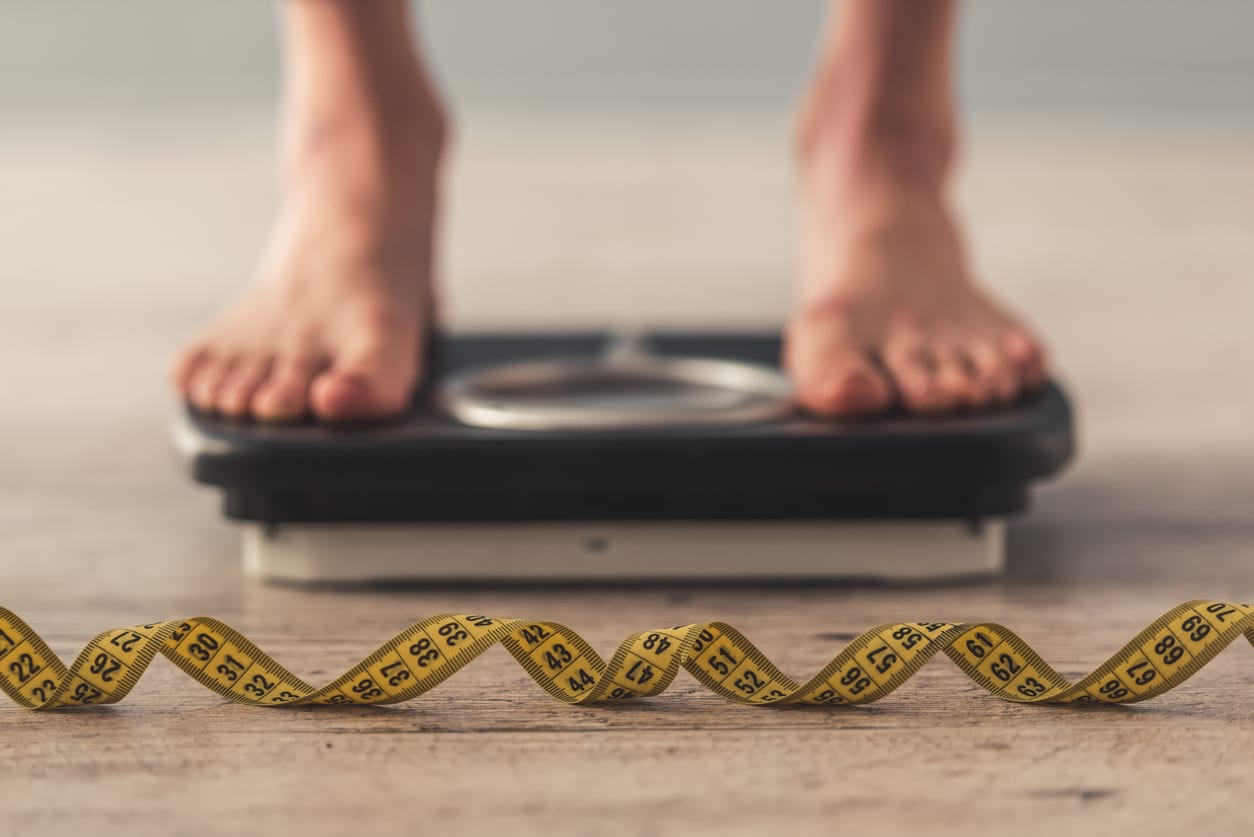
Try Not to Focus Too Much on How Much Weight You’re Losing (or Not Losing!)
If one of your goals when it comes to working out is to lose weight, listen up. You will lose weight when you work out regularly…but it might not always happen as quickly as you want it to.
Everyone loses weight at a different rate. Some people can work out for a week and drop 10 pounds, while others can work out for a month and lose two pounds.
With this in mind, you shouldn’t make losing weight your only motivating factor. Otherwise, you could end up quitting just when you’re about to make a big breakthrough simply because you aren’t patient enough.
Focus on enjoying working out and getting better at exercising as opposed to using the scale as a barometer for how well your workouts are going.
Use Your Workouts to Reduce Any Stress You’re Feeling
It’s safe to say that just about everyone in America is stressed out to some degree right now. A 2017 study found that people are stressed out over everything from health care and the economy to crime and terrorist attacks.
Rather than allowing whatever stress you feel to gnaw at you, why not use it for good? Teach yourself to reduce your stress levels by working out and eliminating a lot of your biggest stresses.
You’ll find that you think more clearly and process stress better after a great workout. You’ll also have a more positive outlook on your life and everything in it when exercise is a major part of your life.
That alone should be enough to inspire you to continue working out over and over again once you start doing it regularly.
Reward Yourself Every Now and Then
There are a lot of sacrifices that are going to come along with working out on a regular basis.
You’re obviously going to be giving up a lot of your time to work out. You’re also going to be giving up money for gym memberships, workout gear, and more. You might even decide to start eating healthier to hit more of your fitness goals.
This is all great! And before long, it won’t even feel like you’re sacrificing anymore. You’ll be gaining so much from working out that your sacrifices will feel small compared to what you’re getting in return.
But don’t forget to reward yourself every now and then for putting in the time, effort, and money to work out. Have an extra slice of cake every now and then or take a day off if you feel like your body could use it.
Avoid Being Too Hard on Yourself If You Miss a Workout or Two
Believe it or not, there’s going to come a time when you–yes, you!–are going to miss a workout and feel guilty about it. There is an anxiety that washes over a lot of people when they’re forced to miss a workout for whatever reason.
It’s easy to beat yourself up over it. Even if you had a completely reasonable excuse for skipping the gym or a run, you’re going to convince yourself otherwise and feel awful.
Don’t worry too much about it. The great thing about exercising is that it’s about more than one or two individual workouts. It’s about committing yourself to lead a healthier lifestyle and then sticking to it over the long haul.
Just don’t let one or two missed workouts turn into one or two months of not working out. It can be tough to get back on the right track once you veer off it. So get back in the gym as soon as you can and continue living your best life.
Enroll Yourself in a Fitness Challenge
Have you tried everything else and found that you still can’t seem to muster up the strength to work out? A fitness challenge might be exactly what you need.
The 9-Week Challenge, in particular, can prove to be beneficial for those who don’t necessarily love to work out. In less than two months, you can totally transform your body by working with a fitness coach while still eating delicious food.
You’ll love the way you look and feel at the end of the challenge, and it’ll put a good foundation in place for you to continue to eat right and work out more than you did before.
Once You Know How to Enjoy Working Out, It Won’t Feel Like a Chore
It’s not as hard to learn how to enjoy working out as you might think. Even if you absolutely hate the idea of doing it now, you can transform yourself into a workout warrior in no time.
Start by setting some goals for yourself and easing your way into a routine. Then, try some different workouts and set up a workout journal, and before you know it, you’ll be a regular. It’ll turn out to be the best decision you’ve ever made.
Read our blog for more information on setting up a workout routine for yourself or contact us with any questions you might have.
Our 21 Day Body Transformation Challenge combines diet and exercise to transform your look. If you want to turn heads for the right reasons, find out more here.
-
10 Quick And Healthy Low-Carb Snacks That’ll Help You Ditch The Chips
10 Quick And Healthy Low-Carb Snacks That’ll Help You Ditch The Chips
Are you addicted to carbs? Here are some healthy low-carb snacks that will make you want to break up with those cookies and chips.
You’re out and about running errands. Then, all of a sudden, hunger pangs strike!
What do you do? Perhaps your first instinct is to grab a snack for a quick energy boost, such as a candy bar, cookie, muffin, or chips. If you’re trying to lose weight and keep fit, obviously none of these snacks will cut the mustard.
Thankfully, with a little bit of forethought, you can choose low-carb snacks at the grocery store that’ll not only provide great nutritional value but also keep you on the right track health-wise.
Here are 10 best low carb snacks you can chow down when you need to keep those hunger pangs at bay.
1. Nuts
Nuts can be ideal no carb snacks. They contain healthy fat, fiber, and protein all in a single package and most are packed with nutrients.
But there two things to keep in mind when it comes to eating nuts:
- Some nuts, like cashews, actually contain a sizable amount of carbs.
- Some people find it difficult to stop when they’re eating nuts.
Make a small pot every morning and gnaw at them all day. But don’t eat too much as the carbs may soon pile up. Carefully monitor your portion sizes.
Eat lower carb nuts like almonds and macadamia. Steer clear of cashews.
2. Seeds
The most readily available seeds are pumpkin seeds and sunflower seeds. Chia seeds and flax seeds are other amazingly nutritious low carb snacks.
Almost all their carbs are in fiber form, which won’t raise your blood sugar. And, as a rule, check the number of carbs in seeds when you buy some from the convenience store.
Store seeds in the fridge. Only take out the portion you want to eat at a time. If you carry them to work, use little snack-sized zip bags.
3. Deli Meat
Any cold piece of deli meat is good to have at hand. Leftover meatballs, leftover roast meat, sausages, bacon, etc. are all easy and healthy low-carb snacks.
Be sure to pick meat with minimal processing, like bacon with no sugar or honey, ham off the bone, salami/pepperoni with at least 98% meat or fat and minimal additives, and sausages with at least 85% meat.
4. Berries
Berries are an amazing source of antioxidants and vitamin C, which helps fight disease, low immunity, and aging.
Eat fresh berries, or suck on frozen ones. You can also add some coconut cream or full-fat cream.
Buy different kinds of these low carb sweet snacks to receive all the different properties and nutrients they offer.
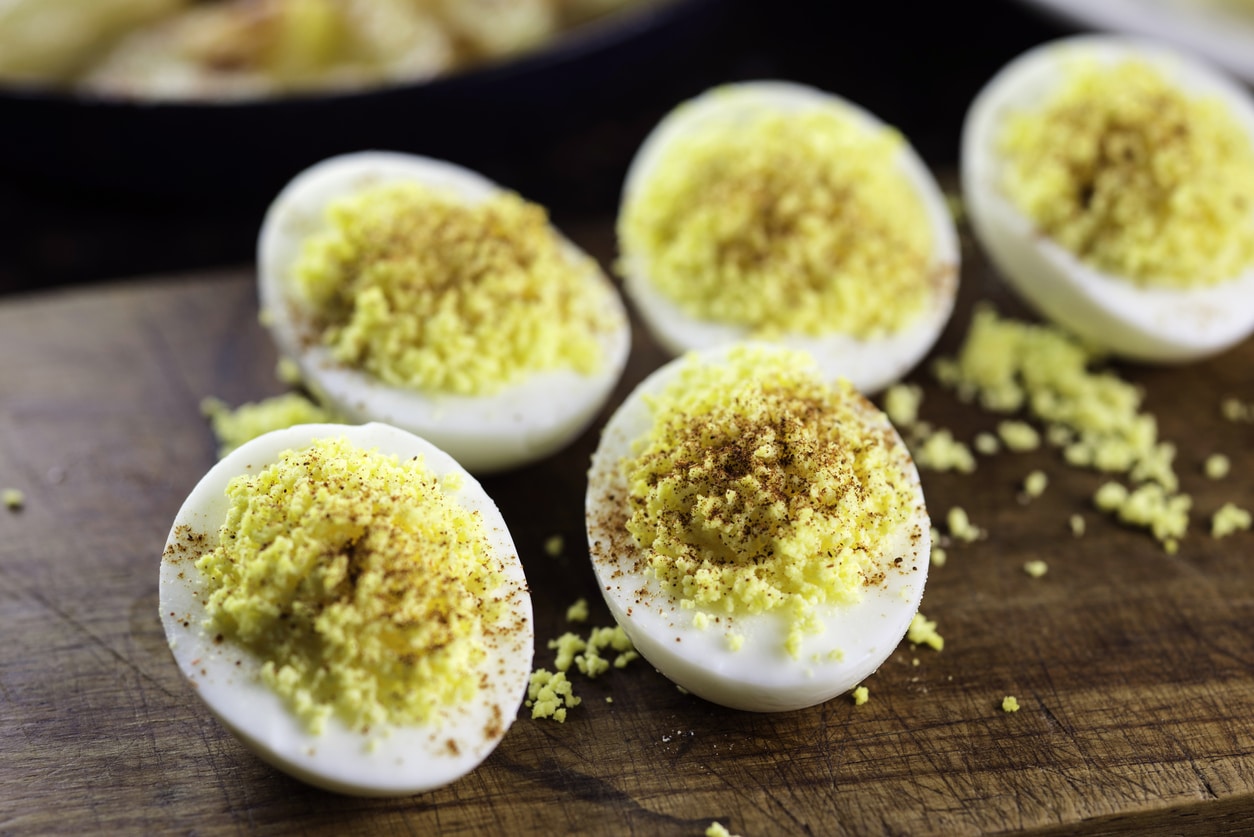
5. Hard-Boiled Eggs
Keep some hard-boiled eggs in your freezer. They’re a simple, convenient snack with a fair amount of fat and protein to keep your appetite under control.
Occasionally, you’ll find hard-boiled eggs at your local convenience store. They’re the ultimate snack, packed with vital vitamins, protein, and minerals. In fact, the egg white contains over half of the protein, along with vitamin C, lots of B vitamins, copper, iron, zinc, and selenium.
One big hard-boiled egg contains less than one trifling gram of carbs. Make sure to also eat the yolk as it contains all of the vitamins.
6. Raw Vegetables
Raw vegetable snack packs are becoming a pretty common sight in grocery stores.
Celery is a great choice with only a gram of carb in a 3-ounce serving. Meanwhile, three ounces of broccoli and carrot have 3 and 6 grams of carbs respectively.
You can dip your veg in peanut butter, low-fat or non-fat Greek yogurt, hummus, or low-fat cream cheese.
7. Beverages
It’s never been easier to find a low-carb drink in the grocery store.
Some great virtually carb free snacks include diet soda (0 carbs), unsweetened coffee or tea (0 carbs), unsweetened vegetable juice (11 gm), plain low-fat milk (11 gm), and coconut water (9 gm of carbs).
Another great option is plain sparkling water, which can lessen your hunger until you get back home.
8. Kale Chips
Kale is a low-carb snack, so you can munch a bit more of this delicious green without actually going too fat with calories.
It’s also nutrient-dense, and eating fewer carbs while keeping the micronutrients high is essential for your overall health.
For example, kale is loaded with B vitamins, which are crucial for converting carbs, proteins, and fats into energy. If you don’t receive enough B vitamins, your metabolism gets into sloth mode.
To make simple and quick low carb chips, drizzle kale leaves with ultra virgin olive. Add some pepper and salt to taste. Bake for 10-15 minutes at a temperature of 350 degrees.
Remember, 100 gm of kale has just 8 gm of carbs and 4 gm of plant-based protein. Enjoy!

9. Greek Yogurt
Yogurt is a breakfast favorite for many of us, but it’s also perfect for dessert. Greek yogurt is low in sugar and fat and full of protein, so long as you buy the unsweetened variety.
It’ll keep you satisfied for several hours, making it an amazing snack. You can also sweeten Greek yogurt with cinnamon and add chia seeds for extra energy, fiber, and calcium.
Greek yogurt is basically high in flavor and low in carbs.
10. Hot Dogs
You can take this snack as a last resort if you don’t find anything else to eat in the store. But make sure to chuck the bun! Regardless of the bad rap they’ve received, hot dogs are absolutely fine in a pinch, providing 2 gm of protein and just 2 gm of carbs.
Although high in cholesterol and sodium, hot dogs make for a much healthier snack than a store-bought brownie (21 gm of carbs) or a pack of potato chips if you’re trying to eat healthily and stay in shape.
Final Verdict on Low-Carb Snacks
It’s quite hard to stay healthy when your freezer is filled with chips, cookies, and donuts.
Instead of gorging on high-carb snacks that’ll pile on the pounds, give these low-carb snacks a try. You can easily make them at home or get them at your local convenience store.
Our 9-week challenge can help transform your body from the inside out as you embrace healthy snacks instead of calorie-filled chips and cookies.
Our 21 Day Body Transformation Challenge combines diet and exercise to transform your look. If you want to turn heads for the right reasons, find out more here.
-
Low on Weights? 12 Creative Ideas for Resistance Training Without Weights
Low on Weights?
12 Ideas for Resistance Training Without Weights
Don’t think you have the budget to get fit? Think again! Try these creative ways to log your resistance training without shelling out for a weight set.
Staying fit doesn’t require a gym membership, nor does it require setting aside a block of time for a full work-out. You can build a resistance training program that can be done anywhere and at any time. Best of all you eliminate the pressure of exercising in front of others.
Imagine working out at the beach on Sunday, in your backyard on Monday, and the park on Tuesday. Experiment and find an inviting place to work out where you are most energized. Grab a yoga mat and get to work using the best bodyweight exercises for your desired results.
Develop a plan and work at your own pace reaching your individual goals. Exercise routines that are free of equipment give you the same results as weights if you know how to work the right muscles.
Ready to work-out without spending money on equipment? Continue reading for 12 resistance training ideas that don’t require weights.

1. Lunge Variations
Lunges are a popular way to do leg workouts at home. There are numerous versions, so you never get bored.
The standard variation, or bodyweight lunge, requires you to stand up straight with your shoulders back and chin up. Step forward with your left foot and with a tightened core, lower your hips and bend your knees at a 90-degree angle. Keep your left knee level with your ankle and lower the back knee, but do not let it touch the ground.
Using your front heel for support, lift the body back up into the standing position. You can do multiple reps with the left knee leading and then switch to the right.
Once you’ve mastered the lunge, switch it up and incorporate the following into your sets.
Curtsy
The curtsy gets its name from the British greeting for women and girls. In this variation, you will start with your feet hip-width apart. Step backward with one leg and cross it behind you. Follow the steps of lowering your body.
Reverse
With the reverse lunge, you will follow the same steps as the standard lunge. In this rep, the emphasis will be on the back leg. Use it to lower the body, and the ball of the foot to lift the body back up.
Walking
The walking lunge follows the steps of the standard lunge. Instead of doing reps with the left leg and then the right leg, you are going to switch things up. After returning to the standing position step forward with the right leg and go into the lunge.
Continue the motions and move around the room. This is a good time to incorporate small weights if you have them. Raise your hands to shoulder height and reach to the ceiling with each step.
2. Burpees for Resistance Training
Burpees are a good exercise and the key benefits is strength building. There is a burpee for beginners. Once you master these motions we’ll get into the advanced version.
Start in the standing position. Squat down and then kick your legs back until you are positioned on your toes. You will be in a position similar to a plank (we will cover planks later). Bring your legs back into a squat and stand back up with your arms reaching upward.
Continue doing this until your motion becomes fluid.
Now that you have the burpee down interject a push-up when the body is in plank position. Follow that up by jumping up instead of merely returning to the standing position.
3. Mountain Climbers
Mountain climbers give you a full body work-out. It also increases your heart rate for a high-quality cardio exercise and a natural shot of energy.
With your arms at your side and feet shoulder-width apart, squat to the floor and position your hands shoulder-width apart on the floor. Go into the plank position with your arms straight. Do not lock your elbows.
Begin with your left leg. Bring it forward with your knee towards the chest, extend it back out and bring up the right knee. Continue this rotation for your desired set of reps.
Between sets bring both feet forward and jump up similar to a burpee. Rest for about 15 – 30 seconds before starting the next set of reps.
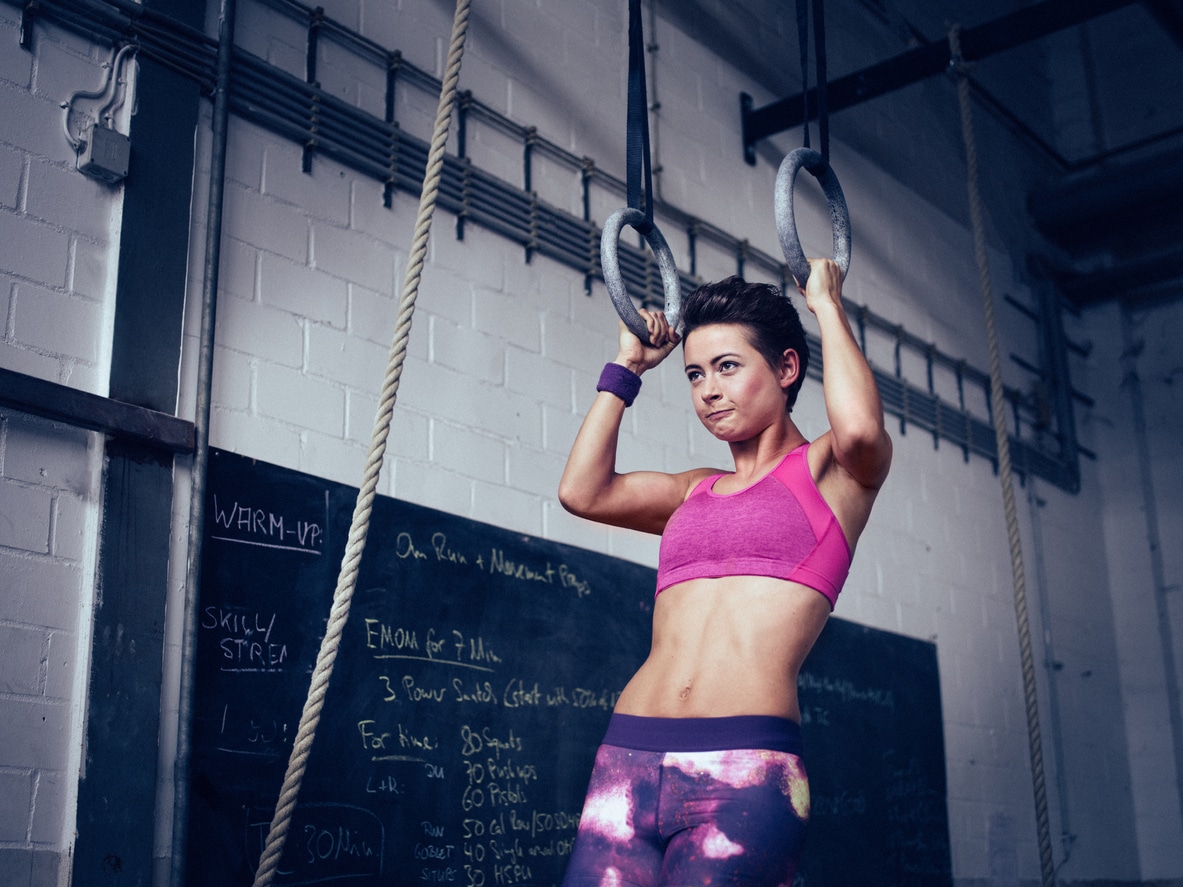
4. Chin and Pull Ups
These upper body exercises will require a sturdy bar high enough to extend your arms over your head. Your feet should not touch the ground between reps. If you are tall or the bar is too low, bend your knees and cross your feet at the ankle.
The difference between the two exercises is the positioning of the hands on the bar. The biceps will get a good work out but the pull-up will have more emphasis on the muscles in the back.
Start with your arms straight but do not lock your elbows. With your hands on the bar shoulder-width apart, pull yourself up until the chin passes the top of the bar. For the chin-up, the palms of your hands will be turned inward. Having the palms turn outward is the position for the pull-up.
Once you have pulled the body up, hold the position for several seconds before descending back down.
5. Planks
Planks, like lunges, can be done in numerous variations. If you’re looking for at home exercises, place this one at the top of your list. We do suggest that you have a yoga mat or some other protective cushioning for your elbows.
The simple forearm plank is used to strengthen the core muscles by forcing you to stabilize your body. For this exercise lie on the ground with your body face down and feet spread waist-width apart. When you lift-up into the plank position you will be supported by the toes and ball of the feet.
Rest your body on your elbows with the forearms resting on the floor and hand clasped. The elbows should be shoulder-width apart and your body straight using your core muscles. Hold the position for at least one minute and challenge yourself to increase the time with each rep.
6. Push-Ups
Do push-ups for resistance training to strengthen the triceps. They also work to build your core muscles. Push-ups can be done the traditional way or the less strenuous method designed for women. You also can vary the placement of the hands to direct the elbows outward or backward.
Stretch out on the floor face down. With your hands should-width apart and in the desired position bend your elbows and push the body up.
To start the exercise, bend the elbows and lower your body stopping before the chest or breast touch the floor. Do short counts before pushing the body back up. Remember, when the arms are straightened, stop before the elbows lock.
Do as many reps as you can before coming to a full rest.
7. Posing for Balance
Resistance training isn’t just about toning, it is also about building core strength that helps the body support your spine. Posing are exercises that help with balance which is the result of a strong core. You will find these techniques in yoga classes but they also provide good at home exercises.
Chair
You won’t need a chair for this pose because you will become the chair. Stand with your feet together. Put your weight into the heels of your feet as you bend your knees into a sitting position. Raise your arms upward with palms touching.
Hold the pose for a minimum of 10 seconds and then repeat the motion.
Tree Pose
Stand straight with your feet flush together. Bring your right foot up and rest it on either the inside of your lower left thigh or below the left knee. Turn the right knee outward and bring your hands up to the center of your chest pressed together.
Take a deep breath and hold the pose for three – five seconds. Release and repeat.
8. Jumping Jacks
If you had physical education classes in school you should have jumping jacks mastered already. Some people may not think of them for resistance training but they are a total body workout. Jumping jacks target the glutes, quadriceps and hip flexors.
You will also work your shoulders and core muscles. Even better, the help with speeding up your metabolism.
Start by standing straight with your hands down by your sides and palms facing your outer thighs, and feet together. Jump up about two-three inches from the ground spreading your legs shoulder-width or wider. At the same time bring your arms out and up until they meet above your head.
Bring your arms back to your side and your legs together. Repeat this motion nonstop as you count out your jumping jacks. A good warm-up would be 50 – 100 jumping jacks.
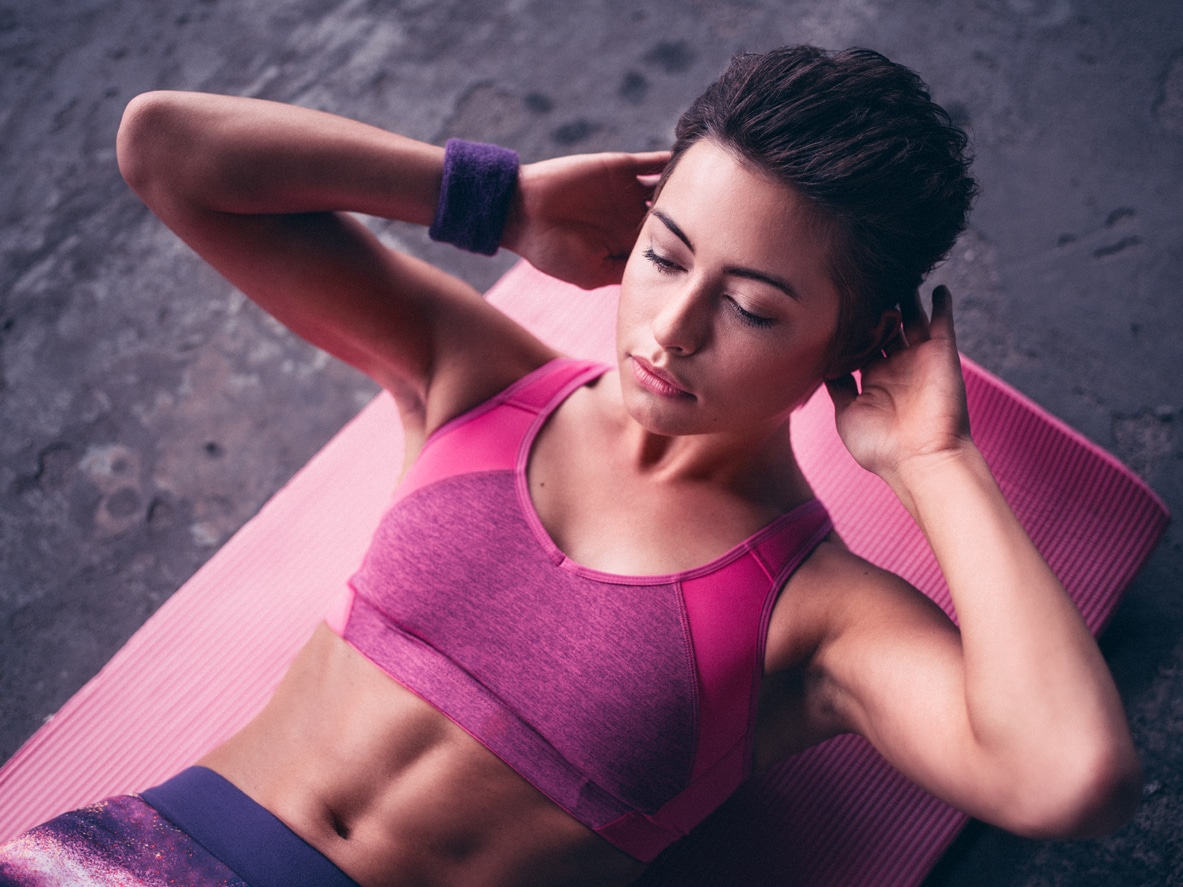
9. Sit-ups
Sit-ups have many benefits, the most popular is tightening stomach muscles and strengthening the core. Here are two variations. Both start with a standard sit-up position.
Russian Twist
With legs shoulder-width apart and the palm of your hands together, bend your knees slightly and lift your legs off the ground. At the same time lift your upper body as if you are doing a sit-up. Twist the torso to the left and then the right, twice.
Exhale and relax the body on the mat. Repeat for the desired sets
Scissors
Position your arms against your sides with palms facing down. Tighten your abs and raise both legs toward the ceiling. Lower the left leg to about two inches from the ground. Raise the left leg while lowering the right.
Repeat the repetition for 30 – 45 seconds.
10. Step-ups
Step-ups are a bodyweight exercise that only requires a sturdy bench that is at least knee high. With hands to you side step-up onto the bench with your left foot. Step down and then step-up with the right.
Your reps can be a straight left leg and then the right, or you can rotate left right left… The goal is to do a continuous 10 step-ups per set. You can also use weights for better resistance.
11. Triceps Dip
Triceps Dip will require a prop. It can be a chair, the edge of a sofa, or a step outside your house. Almost anything that is sturdy and can support your weight without tipping over can be used.
Sit on the edge of the chair with hands shoulder-width apart and palms down. Extend your legs out and then slide your butt off of the chair. Straighten your arms but do not lock your elbows.
Use your arms to lower and lift your body. If using a chair do not go lower than six inches from the seat. When using a step or box that is lower to the ground, do not let your butt touch the surface below you.
Try to perform about 15 reps per set. Return to the seat between sets to allow for a 10-second recovery.
12. Arm Circles
If you are looking for upper body exercises to target the back, shoulders, biceps, and triceps, arm circles are a perfect choice. Arm circles are also a great warm-up exercise that can help prevent injuries.
They are quite simple to execute and can be done while at work during a five-minute break. Start by standing up and extending your arms out with the palms of your hands facing the ground. Do a forward circular motion creating circles that are one foot in diameter.
Continue the rotation for about 10 seconds, or 10 rotations. Stop and then do the same in a backward rotation. One forward and one backward rotation represent a set. You can increase the time of the rotations or the number of back and forth reps, as your arms strengthen.
Also, consider adding small weights for additional resistance.
You’re Now Ready to Log Your Workouts
Now that you know resistance training doesn’t have to come with great expense, what are you waiting for? Before starting your weight-free workouts we recommend consulting with your physician first. Once you get the go-ahead, log your results and celebrate your successes.
Did you find these at home exercises useful? Click here to check out our nine-week body transformation challenge.


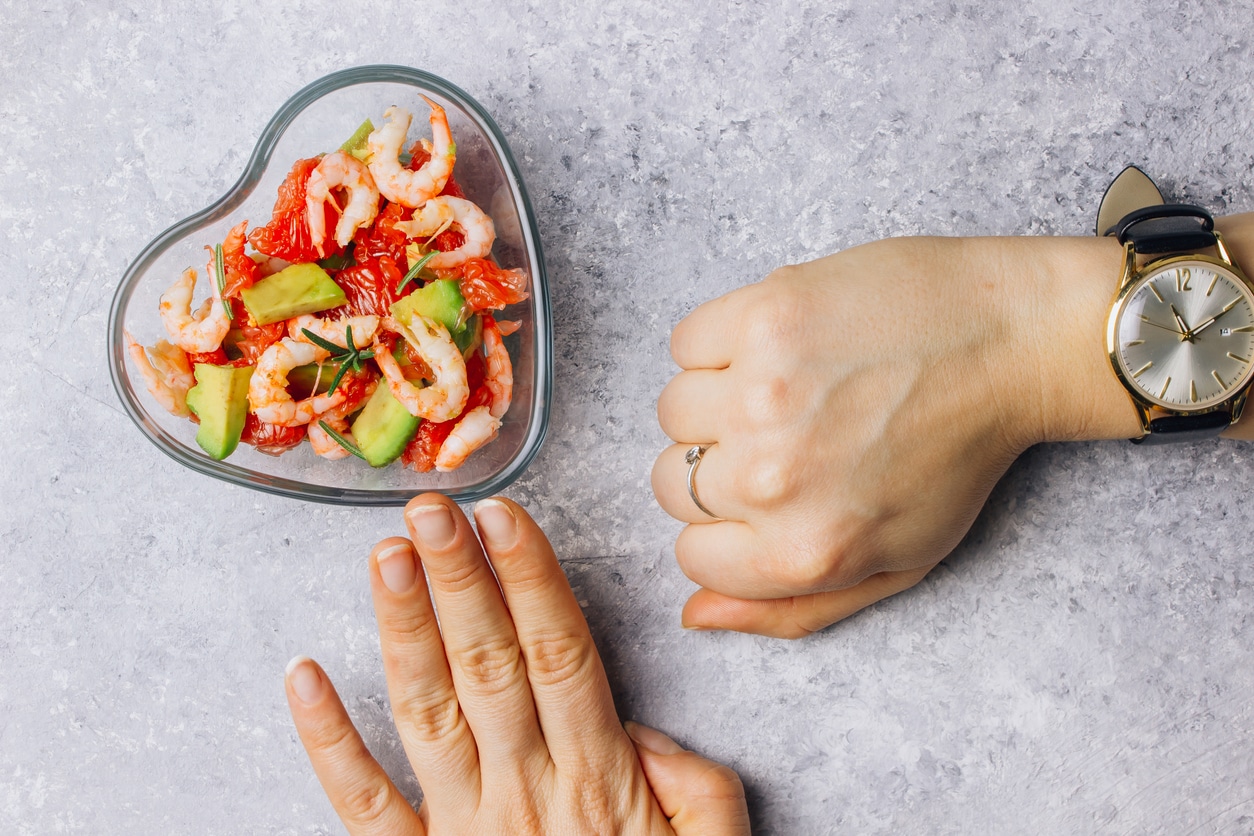


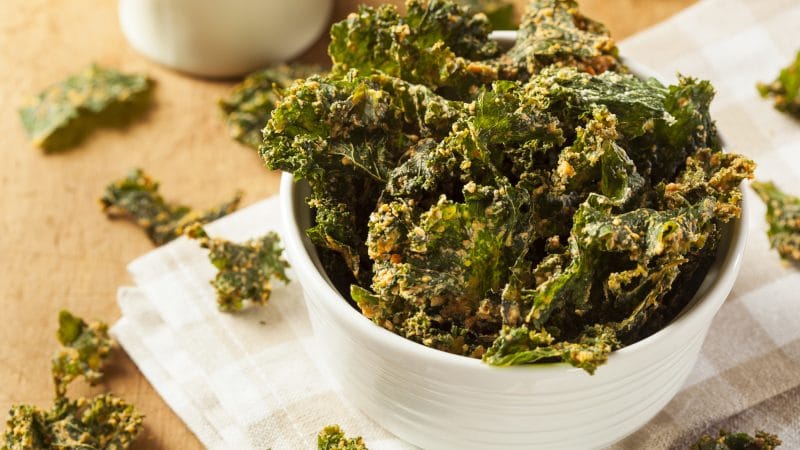
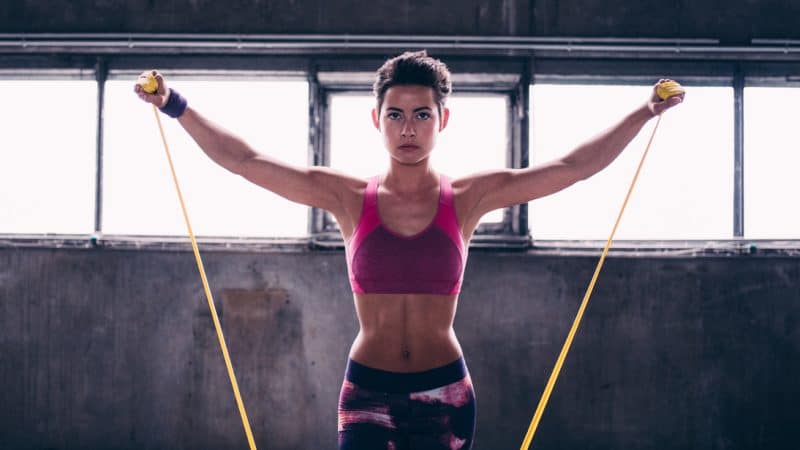

Recent Comments